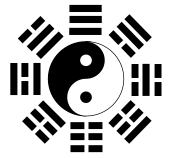

Taoism takes the doctrine of yīn and yáng, and includes it in its own theory of change. Because of that, things that we might expect to be female or male because they clearly represent yīn or yáng, may turn out to be the opposite instead. Of the two basic Chinese "Ways," Confucianism is identified with the yáng aspect, Taoism with the yīn aspect.Īlthough it is correct to see yīn as feminine and yáng as masculine, everything in the world is really a mixture of the two, which means that female beings may actually be mostly yáng and male beings may actually be mostly yīn. Everything in the world can be identified with either yīn or yáng. Yáng represents everything about the world that is illuminated, evident, active, aggressive, controlling, hot, hard, and masculine.

Yīn represents everything about the world that is dark, hidden, passive, receptive, yielding, cool, soft, and feminine. From these basic opposites, a complete system of opposites was elaborated. Yáng in turn meant "clear, bright, the sun, heat," the opposite of yīn and so the lit, south side of a mountain or the lit, north bank of a river. Yīn originally meant "shady, secret, dark, mysterious, cold." It thus could mean the shaded, north side of a mountain or the shaded, south bank of a river. The implications of the theory are displayed in the great book of divination, the I Ching,, the "Book of Changes." Later its theories were accepted by nearly everyone, but especially by Taoism. In the Spring and Autumn Period there was actually a Yin and Yang School. These can also simply be called the "two forces," (where ch'i,, is the "breath" or vital energy of the body, but also simply air, steam, or weather). In China, the theory of five elements coexisted early with the theory of two forces: and. Yin relates to condensation and materialization which can create contraction which descends.In India the theory of the three elements in the Chândogya Upanishad led to the theory of the three forces, the guṇas, and to the later theory of five elements. The Yin Yang symbol below relate to the first correspondences of Yin and Yang.Īn example of transformation of Yin and Yang: Yang relates to creation and activity, which can transform into expansion that rises. At night or yin time, involves a time of rest and inactivity. Since the day time is the time of act ivity it is attributed to Yang. The earliest origin of Yin and Yang must have come from the observation of day turning into night and night turning into day. He said, “The mountain has a Yin side (shaded) and a Yang side (sun drenched), and each of those sides contain Yin qualities and Yang qualities, just as the river, just as life (translation).” The relationship of Yin and Yang can be represented in the famous Tai Ji symbol. Master Jin Huai Wang once explained these concepts of Yin and Yang. Yin is constantly changing into Yang as Yang is constantly merging in to Yin. The symbol is showing that nothing can be totally Yin or totally Yang in nature. Yin contains a seed of Yang, and Yang contains a seed of Yin which is represented by the dots within each color. Yin and Yang are opposite stages, but they form unity and are complementary.


 0 kommentar(er)
0 kommentar(er)
